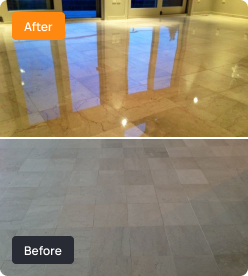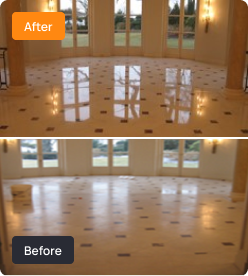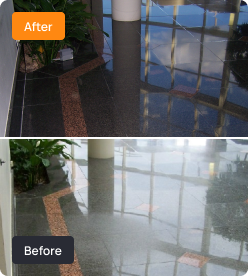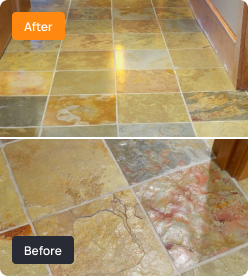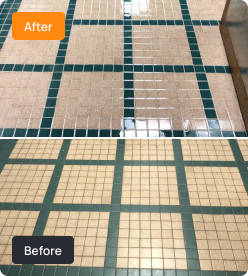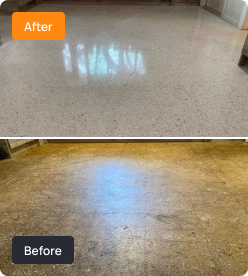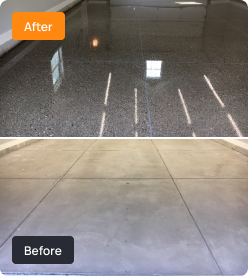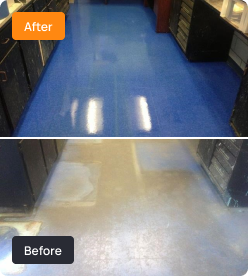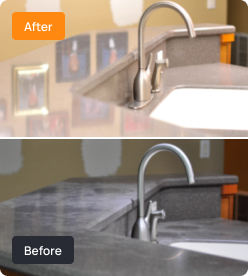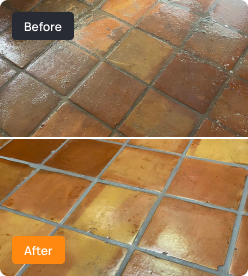Residential Limestone Floor Cleaning and Maintenance: A Comprehensive Checklist!
Worried about your limestone floor at home? Planning to bring back the same life and luster they once had when you welcomed them in for the first time? Fret not! Team MARBLELIFE is here to help you understand all about limestone floor, limestone cleaning, and limestone maintenance. Why the Fuss: What Makes Limestones […]


Worried about your limestone floor at home? Planning to bring back the same life and luster they once had when you welcomed them in for the first time?
Fret not! Team MARBLELIFE is here to help you understand all about limestone floor, limestone cleaning, and limestone maintenance.
Why the Fuss: What Makes Limestones the Go-To Choice for Flooring?
In 2019, following the demise of renowned designer Gloria Vanderbilt, various architectural and real estate publications reminisced on some of the magnificent properties she resided in during her lifetime.
One of her assets includes an eight-bedroom townhouse in Manhattan’s Upper East Side.
The seven-story building, dating back to 1891, boasts of its well-preserved limestone flooring, which has retained its pristine state for over a century.
Although marble and granite are known for their luxurious appeal, limestone possesses a unique charm that sets it apart. Limestone tiles are a popular choice for flooring due to their stunning appearance.
From the gorgeous design of the Pyramids of Giza of the sovereigns to the glamorous, opulent houses of Beverly Hills, architects’ fascination with limestone has remained strong and continues.
Let’s have a look at how limestone is formed to understand how and why it gets its natural brilliance.
Limestone Overview: Formation, Properties, and Applications
How Limestone is Formed?
Limestone, a sedimentary rock, is formed from the accumulation and cementation of shells, corals, and marine organisms on the ocean floor.
Over millions of years, as marine organisms die, their remains sink and collect in layers, compressed under their weight.
Simultaneously, the chemical precipitation of calcium carbonate in areas with thermal springs or oceans aids in the formation of limestone.
The resulting limestone and travertine have a remarkable capacity for preserving fossils within their stone matrix, occasionally capturing and retaining exquisite remnants of ancient life.
Limestone: Porosity and Significance
Naturally, limestone possesses a porous structure with small openings or spaces capable of retaining water or other fluids.
These openings are formed by gases released during the decomposition process of marine animals that contribute to the formation of these deposits.
These gaseous releases create natural gaps between the mineral grains constituting the rock, resulting in its inherent porosity.
However, the degree of porosity in limestone can vary depending on the type and amount of mineral content present.
Some limestones exhibit a highly porous structure, while others have a more solid composition. Based on these two properties, limestone has found application in many walks of life.
What are the Common Applications of Limestone other than Limestone Flooring
- Many artists utilize porous limestone as a medium for their sculptures due to its natural texture and ability to absorb and retain colors.
- Porous limestone is particularly advantageous for constructing buildings in areas with a high water table, as its properties can be harnessed to facilitate a natural drainage system.
- In agriculture, crushed limestone is commonly used as a soil amendment to improve soil structure, manage moisture levels, and enhance drainage.
- Porous limestone serves as a reservoir rock for oil and gas, owing to its capacity to store and transmit fluids.
Limestone Cleaning and Maintenance: How to Keep Your Residential Limestone Beautiful Forever
Preserving and maintaining the beautiful appearance of limestone is relatively easy as long as one avoids contact with acids that can dissolve or etch the stone.
Proper prevention and the right cleaning and sealing routine make it possible to keep limestone looking stunning.
1. Limestone Cleaning Tip#1: Sweeping
Preserving and maintaining the beautiful appearance of limestone is relatively easy as long as one avoids contact with acids that can dissolve or etch the stone.
Proper prevention and the proper cleaning and sealing routine make it possible to keep limestone looking stunning.
Keeping your limestone floors clean is crucial for preserving their natural beauty. While limestone is a relatively soft stone, dirt, dust, and sandy particles can risk scratching the surface when stepped on.
However, you can prevent this by regularly sweeping the floor with a soft bristle broom or a dust mop. This simple maintenance routine helps protect the floor’s finish and extends its lifespan.
It’s also essential to choose suitable entrance mats for your building. A standard “welcome” mat might not be enough to trap abrasive materials.
Look for mats that can effectively capture these particles and prevent them from being tracked indoors.
When cleaning the limestone, use a wax-free, oil-free, and non-acidic oil-emulsifying cleaner.
This type of cleaner will help maintain the natural beauty of the stone without worrying about damage from embedded particles.
Avoid using cleaners that contain acids, as they can cause etching or dulling. Similarly, avoid wax or excessive oil cleaners, as these can create buildup and require more extensive maintenance.
The frequency of sweeping will depend on foot traffic and the environment. More frequent sweeping will be necessary for areas with high sand content, like beaches, to prevent potential damage.
2. Limestone Cleaning Tip#1: Mopping
Most of us think we know how to mop a floor, but there’s a crucial mistake that many people make.
Cleaning with a wet mop can move dirt from the tile top to the grout line, which can be absorbed and result in stained grout lines. Instead, a damp mop is ideal as it allows dust and dirt to stick to it, which is lifted off the floor and into the mop bucket.
This method is more effective, similar to picking up a corner of a piece of paper with a moist fingertip.
The frequency of cleaning your limestone floors can depend on foot traffic, but selecting the right product is crucial to enhancing their aesthetic.
We recommend using MARBLELIFE MARBLE & TRAVERTINE CLEANER CONCENTRATE when cleaning your limestone floors to achieve the best results.
Limestone is a form of marble, and as such this product is tailor made for this surface, This non-acidic, wax-free, oil-free, scent-free surfactant concentrated cleaner is an exceptional degreasing cleaner.
It is even formulated to reduce the frequency of mop bucket water changes needed, but capturing dirt and then dropping it out of the way to the bucket bottom to keep the water as clean as possible for the next time you dip you mop in.
Managing Dust, cleaning with the right product are 2 of the 3 requirements to maintain your limestone’s beautiful finish and clean appearance.
When it comes to mopping floors, there’s a common mistake many people make.
A wet mop can transfer dirt from the tile surface to the grout lines, leading to stubborn stains.
But there’s a better way. Instead, opt for a damp mop that traps dust and dirt, lifting them off the floor and into the mop bucket.
Think of it like picking up a piece of paper with a slightly moist fingertip. This method is more effective and prevents dirt from settling in the grout lines.
The frequency of cleaning your limestone floors depends on foot traffic, but choosing the right cleaning product is essential to enhance their appearance.
For the best results, we recommend using MARBLELIFE MARBLE & TRAVERTINE CLEANER CONCENTRATE for your limestone floors.
This specially designed cleaner is perfect for limestone surfaces as it’s non-acidic, wax-free, oil-free, and doesn’t leave any strong scents. It effectively removes dirt and even helps keep your mop bucket water cleaner longer.
By managing dust, using the right cleaning product, and following a regular cleaning routine, you can maintain your limestone floors’ beautiful finish and keep them looking their best.
3. Limestone Cleaning Tip#3: Sealing
Maintaining and caring for limestone requires sealing, which is often overlooked but crucial.
Without sealing, cleaning can cause a dulling effect as dirt seeps into the stone’s open pores. Once inside, it’s difficult to remove because it’s not just on the surface but within the stone itself.
Many older buildings may not have been sealed because this technology is relatively recent. However, sealers can help protect against spills and give you more time to clean them up.
Another misconception is the belief that once sealed, permanently sealed. Acids can damage sealers, which means spills or cleaning with vinegar or lemon-based cleaners can remove or harm the seal.
Applying a sealer is easy with its simple wipe-on and wipe-off process. The most significant risk for stains is forgetting to reapply the sealer every other year.
We recommend doing this during daylight savings, coinciding with changing smoke detector batteries.
To reseal your limestone flooring:
- Apply sealer by wiping it onto the surface and allowing it to penetrate the open pores for a few minutes.
- Wipe off the excess to quickly re-protect the surface. You can perform a water test to determine if resealing is necessary.
- Pour water on the surface; if it darkens, it has penetrated and indicates the need for resealing.
Ideally, you want to see the water bead up. For optimal results, use MARBLELIFE STONE SEALER, as it is specifically formulated for this purpose.
Remember that sealing only protects against staining and not etching. Even with a seal, acidic spills can still cause etching or damage upon contact with the limestone.
However, the seal provides time to remove spills and dirt before they cause staining.
Consider using a non-acidic cleaner like MARBLELIFE MARBLE & TRAVERTINE CLEANER to keep your floors beautiful. Since limestone is a form of marble, this cleaner is an ideal choice.
4. Limestone Cleaning Tip#4: Removing Stains
Have you ever tried cleaning the inside of a test tube with a sponge? It’s difficult, just like removing stubborn stains from limestone surfaces.
Simply wiping the surface won’t be effective because the stain is embedded deep within the pores below the floor’s surface.
If regular cleaning doesn’t work, you must use a poultice. This method involves applying a mixture of dry powder and a liquid that can dissolve the stain-causing material.
As the liquid penetrates the wet poultice and moves into the floor, it loosens the stain. When the poultice dries on the surface, it reverses the process, pulling the dissolved stain material back into the poultice.
However, this process can take up to 24 hours and may need to be repeated several times to remove the stain.
It’s important to note that the liquid used in the poultice must match the material that caused the stain, making stain removal more complicated than simply maintaining the seal.
Furthermore, it’s crucial not to seal the surface until the stain has been completely removed because sealing could trap the stain in the stone.
Sealing is a much simpler process than dealing with a stain’s consequences.
5. Limestone Cleaning Tip#5: Minimizing Etching
Regular maintenance is crucial to keep your limestone flooring looking its best and ensure long-term durability.
Whether in residential or commercial spaces, using specially formulated cleaners explicitly designed for marble and limestone floors is essential.
Avoid using acidic cleansers as they can cause etching. The acid in these cleaners dissolves the surface of the limestone, creating tiny pits.
This damage appears as cloudy white marks that are difficult to clean because a cleaner can’t fill in a hole in the surface. Be cautious of cleaners labeled as “lemon fresh,” citrus-scented, or vinegar-infused, as they can all contribute to etching on limestone.
Hard water stain removers are also acidic, and using them on marble or limestone will worsen the problem.
Hard water stains occur due to precipitated calcium carbonate, and anything that can dissolve CaCO3 will also dissolve marble and limestone since they are made of the same material, CaCO3.
How to Maintain Limestone Flooring
Regular maintenance is vital to ensuring the longevity and appearance of your limestone floors. Establishing a maintenance routine is essential, including sweeping or dust mopping regularly to remove dirt and debris.
For mopping, use a non-acidic cleaner mixed with warm water to clean the surface gently.
Avoid harsh chemicals, acids, or abrasive tools that could harm the limestone. Periodically sealing the floors is also essential to protect against stains and moisture damage.
In high-traffic areas like hotel entranceways or office building lobbies, where hundreds or even thousands of people may pass through daily, it’s necessary to restore or re-polish the floors periodically.
After restoration, remember that foot traffic patterns may become visible within 45 days, with areas like elevator buttons, stair landings, registration desks, and entrances showing signs of wear first.
These buildings often feature marble floors to make a statement about their tenants or business success.
A worn-out floor can raise concerns about financial stability. To maintain a quality restored appearance, hiring a professional marble maintenance service is advisable.
Look for a service that understands the science of restoration and can guarantee that the surface will never require restoration again. MARBLELIFE, with over 15 years of experience, has a track record of delivering on such commitments.
Bringing the Original Shine Back: How to Restore Limestone Floors
If your limestone floors have seen better days with wear, scratches, or damage, there’s a cost-effective solution available.
A professional stone restoration company can bring your floors back to life without the hefty price tag of replacement.
The best part? This restoration process doesn’t involve any dust or disruption that typically accompanies removal and replacement.
In fact, most restorations can be carried out without disturbing your regular business activities, as they only require access to small sections at a time (typically around 20 sq.ft.).
By consulting with a professional stone restoration company, you’ll receive expert guidance in assessing the damage, understanding its root causes, and exploring suitable solutions.
This ensures that your floors receive top-notch treatment, allowing them to make a consistent and impressive first impression.
Additionally, partnering with a professional maintenance company will help you keep your surface clean and well-maintained, reducing the need for frequent restoration services.


